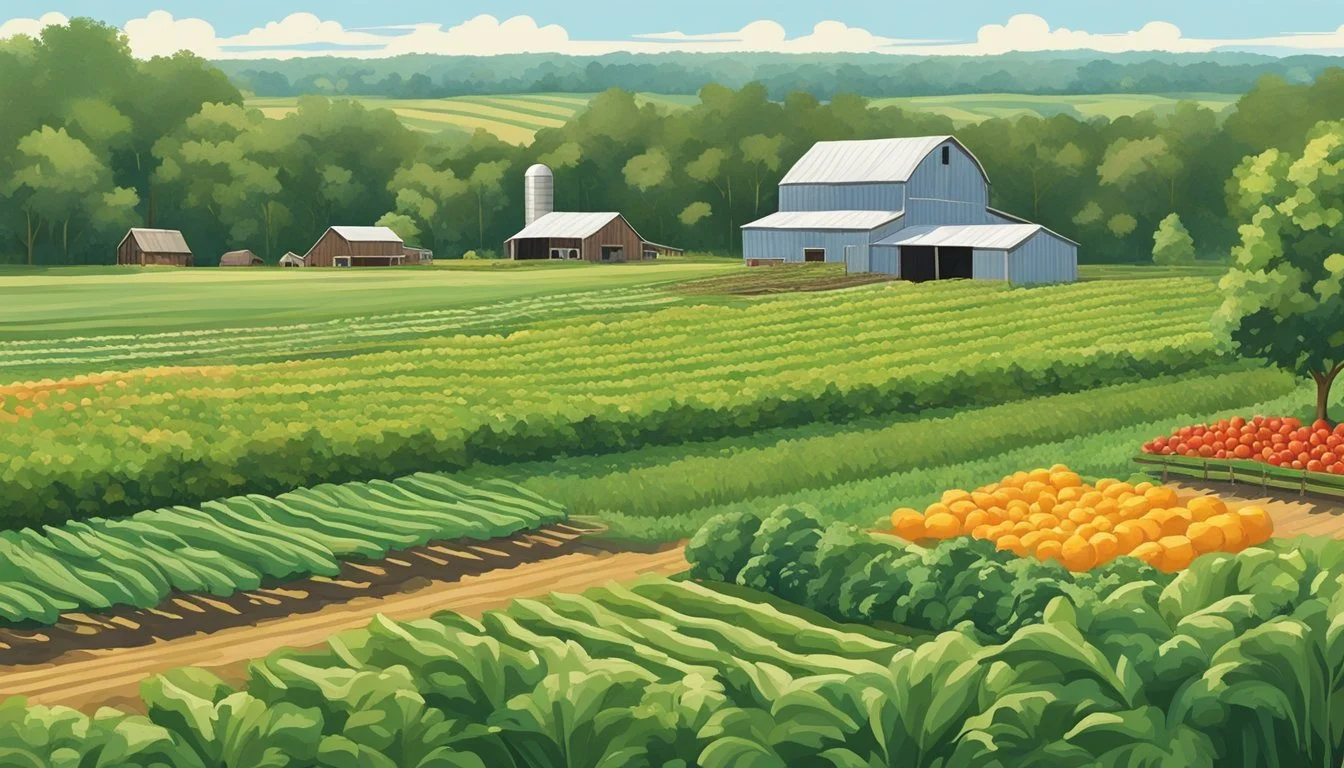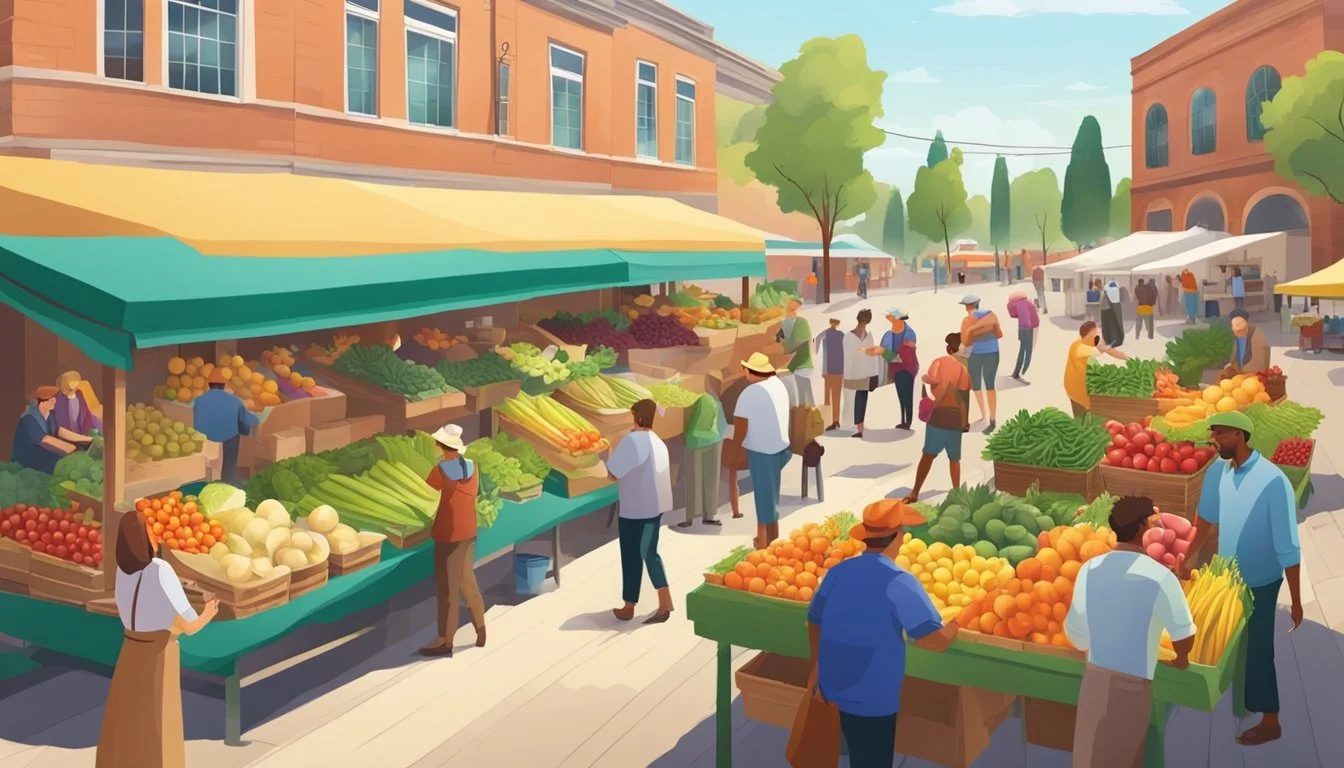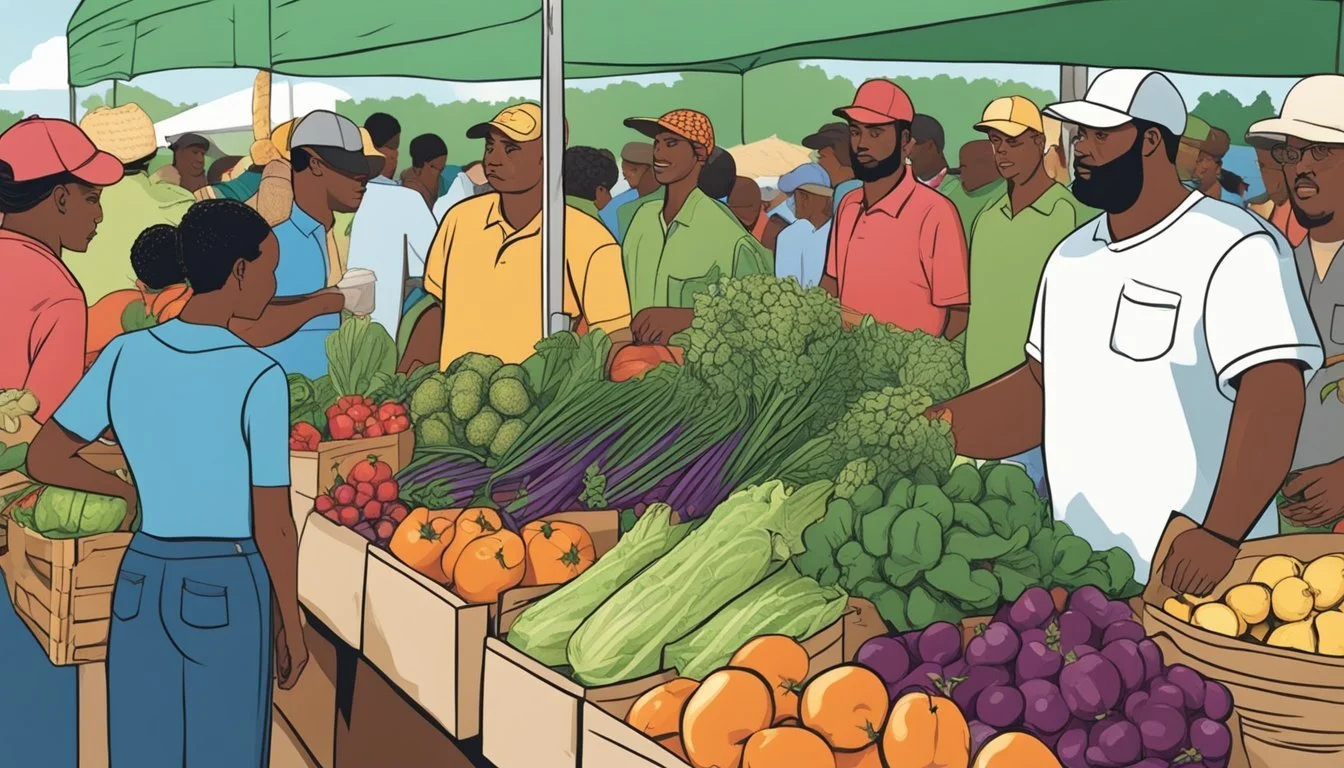Community Supported Agriculture (CSA) in Alabama
A Sustainable Food System Model
Community Supported Agriculture, commonly known as CSA, has taken root in Alabama, offering an innovative model that connects consumers directly with local farms. The concept is simple: members of the community purchase shares of a farm's anticipated harvest, providing financial support to the farmer at the start of the growing season. In return, they receive regular deliveries or pickups of fresh, locally grown produce throughout the farming season. This symbiotic relationship not only fosters local economic stability but also encourages sustainable agricultural practices.
In Alabama, CSA programs are thriving due to the state's conducive climate for various crops. A number of farms have adopted the CSA model to offer fresh, seasonal food to the community while enhancing the viability of small-scale agriculture. These programs typically offer a diverse range of farm products, which may include vegetables, fruits, dairy, eggs, and meat. CSA members have the unique opportunity to experience the rhythm of the agricultural season and develop a deeper understanding of the source of their food.
The CSA model in Alabama emphasizes community engagement and supports the farm-to-table movement. By investing in CSA shares, individuals directly contribute to the success of local farmers, and in doing so, they help to maintain Alabama's rich agricultural landscape. This partnership aids in preserving the region's farming heritage and ensures that Alabamians have access to healthy, locally sourced products.
The CSA Model Overview
Community-supported agriculture in Alabama reflects a nationwide trend where consumers invest directly in local farming operations, sharing both the bounty and risks of agricultural production.
Definition and Core Concepts
Community-supported agriculture (CSA) is a model in which individuals commit to a farm by acquiring memberships or "shares." This relationship supports the farm's operational costs upfront, thereby ensuring a steady demand for the farm's produce. In return, members receive regular distributions of the farm's harvest. The core principle of CSA is the shared risk; if the harvest is bountiful, members benefit, if there are shortfalls, members share in the diminished supply.
History and Origins
CSA originated in the early 1960s in Germany, Switzerland, and Japan as a response to food safety concerns and the urbanization of agricultural land. However, the model didn't take hold in the United States until the mid-1980s. One of the early adaptors of the CSA model in the U.S. was the Indian Line Farm in Massachusetts.
CSA Across the Nation
In the United States, the CSA model has experienced significant growth. Originally small-scale with a handful of farms, the movement now includes thousands of farms providing fresh, locally-sourced food directly to consumers. This form of direct-to-consumer sales is appreciated for its assurance of food provenance and support of sustainable agriculture.
The Role of Robyn Van En
Robyn Van En was a pioneer in bringing the CSA model to prominence in the United States. She co-founded Indian Line Farm, the first CSA in the U.S., and actively promoted the concept nationwide. Her work facilitated the spread of CSA farms across the country, ensuring the model's sustainability and community impact.
Benefits of CSA Participation
Community Supported Agriculture in Alabama provides a symbiotic relationship between consumers, farmers, and local communities, all while contributing to environmental sustainability. This approach gives local community members access to fresh, seasonal produce directly from local farmers, fortifying the bond between the food people eat and the land it comes from.
For Consumers
CSA participants receive a wealth of advantages such as fresher vegetables and produce compared to those typically found in supermarkets. They experience food sovereignty, with a clear traceability of their food's journey from farm to table. Being part of a CSA also offers the unique opportunity to learn about seasonal eating and to discover new types of produce that they might not encounter in a traditional retail setting.
Freshness and Taste: Consumers often report tastier produce due to its freshness.
Education: Participation increases knowledge about agriculture and seasonal eating.
For Farmers
Farmers benefit from the financial security provided by CSA memberships as they receive payment early in the season, which aids in planning and farm operations. This model offers farmers a guaranteed market for their vegetables and produce, reducing the risks associated with fluctuating market demands. It fosters direct relationships with consumers, which can lead to a loyal customer base and valuable feedback.
Financial Stability: Upfront payments support farm cash flow.
Market Assurance: Pre-sold produce assures a reliable outlet for crops.
For Local Communities
CSA helps knit tighter local communities, supporting the local economy by keeping money within the region. It encourages a sense of community ownership and cooperation as community members become active participants in their local food system. Local farms can become centers of educational and social events, strengthening community connections.
Economic Support: Spending on CSA stays local, benefiting the economy.
Community Engagement: Farms often become hubs for local activities and education.
For the Environment
The CSA model plays a critical role in the environmental movement by advocating for sustainable farming practices, which have a lower impact on the environment. It supports biodiversity and helps maintain healthy ecosystems. Reduced transportation for local produce also means a smaller carbon footprint, contributing to the fight against climate change.
Sustainability: Reduced transportation lowers carbon emissions.
Biodiversity: Local small-scale farm operations often use crop rotation and other practices that promote diversity.
How CSA Works
Community-Supported Agriculture (CSA) in Alabama operates as a collaboration between local farms and community members who seek fresh, locally-sourced produce. This mutual relationship is sustained through memberships, shares of the harvest, varied distribution methods, and a structured financial model. The seasonality of production dictates the availability and variety of crops offered through CSAs.
Membership and Shares
In a CSA model, community members purchase a membership from a local farm. This entitles them to a share of the farm’s produce throughout the growing season. Shares vary in size and quantity, often depending on the specific farm's offerings and the consumer's needs.
Quarter Share: Suitable for individuals or small families.
Half Share: Ideal for families that consume more produce.
Distribution Methods
Members receive their shares through a variety of distribution methods:
On-Farm Pickup: Members collect their produce directly from the farm.
Delivery: Farms have schedules for home delivery or to a set drop-off point.
Financial Structure
The financial support for the farm is secured upfront through the purchase of memberships. This allows the farm to fund its operations at the start of the growing season. Members essentially become stakeholders in the farm's produce and share the risks and benefits of food production.
Seasonality and Production
The CSA model inherently follows the growing season:
Spring Shares: Begin in March.
Summer Shares: Last for 10 weeks from late May to July.
Fall and Winter Shares: Scheduled based on seasonal availability.
The production of crops is subject to seasonal changes, which means the variety of produce in each share will vary throughout the year.
CSA Farms in Alabama
Alabama hosts a vibrant network of CSA farms that provide community members with seasonal produce, demonstrating a strong commitment to sustainability and local economies.
Popular CSA Farms
Barber Berry Farm: Located in Millbrook, Alabama, this farm offers a variety of fresh harvests, prized for high vitamin and mineral content.
Seasons in the Sun Farm: Situated in Spanish Fort, they are dedicated to chemical-free, fresh produce through their CSA program.
Other notable mentions are Bee Natural Farm and Red Root Farm, known for their local engagement and quality offerings.
Local Market Integration
CSA farms in Alabama integrate closely with local markets. This not only bolsters local economies but also ensures consumers receive fresh, peak-season produce directly from their community's farmers. Farms like Bee Natural Farm and Red Root Farm foster this connection, reinforcing the farm-to-table movement within Alabama.
Agricultural Practices
Sustainable and ethical agricultural practices are at the heart of Alabama's CSA farms. For instance:
Bee Natural Farm employs natural growing techniques, adhering to organic standards.
Red Root Farm focuses on regenerative farming, aiming to improve soil health and biodiversity.
Consumer Experience
Participating in a CSA program in Alabama offers consumers a unique opportunity to connect with their food sources, securing fresh, locally produced items on a regular basis. They encounter a range of experiences, from choosing a suitable CSA, understanding what they will receive, and forming connections with the people who grow their food.
Selecting a CSA Program
When consumers explore their options for CSA programs, they should consider the variety of produce offered, pricing structures, and delivery methods. Membership to a CSA in Alabama typically involves a recurring payment, which might be structured as a weekly or bi-weekly fee. Consumers should ask questions about the length of the season, pickup locations, and options for visitation to better understand what each CSA entails. They should also review any testimonials or reviews to gauge satisfaction from current or past members.
What to Expect
Members of a CSA program can expect a regular share of the farm's harvest, which might include vegetables, fruits, and occasionally other products like eggs or honey. The contents of the shares vary with the seasons, ensuring a rotation of fresh and ripe produce. It is important for consumers to bear in mind that the nature of agriculture means some unpredictability in what and how much is harvested, which can directly affect what they receive.
Building a Relationship with Farmers
A CSA is more than just a subscription; it fosters a sense of community. Through direct interaction with the farmers, often facilitated by farm visits or regular newsletters, consumers become part of the farm's story. They learn about the challenges and successes of agriculture directly from the source, strengthening the farm-to-table connection and their understanding of sustainable practices.
In these ways, CSA members in Alabama not only nourish their households but also contribute to the local agricultural economy and become integral participants in a community-centered food system.
Economic and Social Impact
Through Community Supported Agriculture (CSA), Alabama is witnessing tangible benefits in terms of economic stability and enhanced social cohesion within communities. This investment in sustainable agriculture is also broadening educational horizons concerning food production and consumption.
Community Support and Investment
In Alabama, CSA initiatives are inviting residents to become stakeholders in local agricultural ventures. These members infuse funds directly into farms, ensuring a stable economic model that benefits producers and consumers alike. Farms like those adopting the CSA model in Alabama provide a share of the harvest to local residents or those from nearby metropolitan areas in return for seasonal or annual investments. This symbiotic relationship underpins the financial viability of smaller farms and nurtures community bonds.
Economic Sustainability
CSA farmers benefit from upfront capital that improves their cash flow and reduces the financial risks associated with farming. The economic exchange is straightforward: members' investments lead to a secured market for farmers, while members gain access to fresh, local produce. The growth of CSA in Alabama implies an economic shift towards more localized and resilient food systems, with members actively supporting agriculture that avoids the pitfalls of mass farming practices.
Social Networks and Food Education
CSA is fostering social networks through a unified interest in sustainable agriculture and food education. Members typically gain insight into farming processes, seasonality, and environmental stewardship as part of their involvement. Educational components often facilitate understanding of the value of supporting local agriculture. Heron Hollow Farms, for instance, not only offers bi-weekly produce delivery but also opens up an avenue for members to learn about the connective threads between their food and the environment.
CSA Challenges and Considerations
Community Supported Agriculture (CSA) in Alabama is not without its unique challenges and considerations. These factors play a crucial role in the sustenance and growth of CSA, requiring careful management and robust communication channels between consumers and farmers.
Limitations and Risks
CSAs often involve shared risks between the producers and the consumers. In Alabama, weather variability can heavily impact the success of crop yields. CSA members must understand that they share in the potential crop loss due to drought, floods, or pests, which can influence the quantity and variety of produce they receive. Additionally, there is a limitation in the types of products offered; CSAs usually focus on seasonal and local produce, which might not cater to all consumer preferences.
Management and Planning
Effective management strategies are critical for the success of a CSA. Farmers must meticulously plan their crop rotations, harvest schedules, and distribution logistics to meet the expectations of their CSA members. This entails not only a deep understanding of sustainable agricultural practices but also an entrepreneurial acumen to ensure financial viability. As CSA enters the 21st century, embracing technology for management purposes, like inventory tracking and efficient distribution systems, has become increasingly important.
Consumer-Farmer Communication
Clear and consistent communication is the bedrock of any successful CSA. It enables the community component of CSA, fostering a strong relationship between consumers and farmers. Alabama CSA farmers must provide regular updates on the status of crops and any changes that may affect their shares. On the other hand, consumers should provide feedback to help farmers tailor the CSA experience to community needs and preferences. Transparent communication can also help set realistic expectations for what being part of a CSA means, which is intrinsic to maintaining a positive, trusting relationship.
CSA and the Future
The future of Community Supported Agriculture (CSA) in Alabama holds promising developments in adapting models for efficiency, widening the network of CSA’s influence, and garnering governmental support.
Innovation in CSA Models
Modern CSA models are embracing advancements in technology and management practices to meet consumer demand efficiently. An example is the integration of online platforms for subscriptions and payments to streamline operations. CSA programs, such as those mentioned in the 2009 survey of community-supported agriculture producers, are increasingly adopting software solutions for inventory management and communication, reducing the administrative load on farmers and enhancing the customer experience.
Expanding CSA's Reach
Expanding CSA's reach involves increasing consumer awareness and accessibility. Programs are not only targeting local residents but also recruiting members from metropolitan areas, demonstrating growth in community engagement. They are undertaking strategic outreach efforts, including partnerships with local businesses and community organizations, to tap into a broader customer base. By ensuring a diverse produce selection and flexible share sizes, as described by farms like Kith & Kin CSA, more families may see CSA as a viable option for obtaining fresh, farm-sourced food.
Policy and Supportive Frameworks
CSA's sustainability is further cemented by conducive policies and frameworks. Organizations such as SARE (Sustainable Agriculture Research & Education) aid in this regard by providing grants and educational resources. These efforts not only improve CSA operations but also promote the system's economic viability. Recognizing how critical such support structures are, there is continuous advocacy for policy development at both the state and federal level to provide more substantial support and recognition for CSA models, ensuring their role in the future of agriculture.










